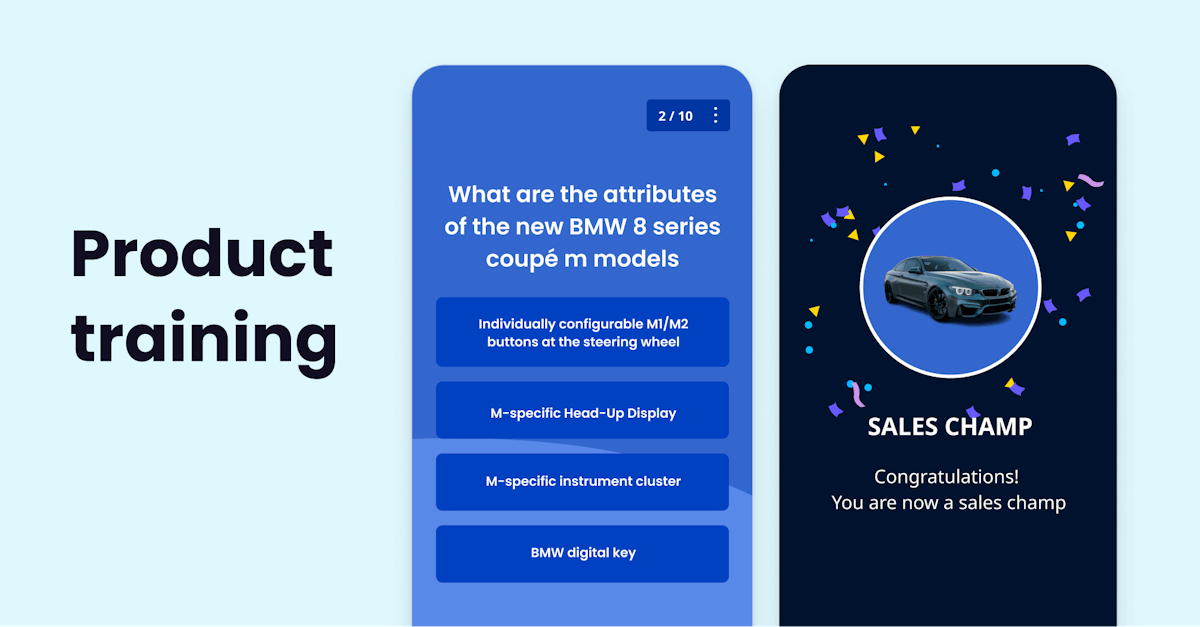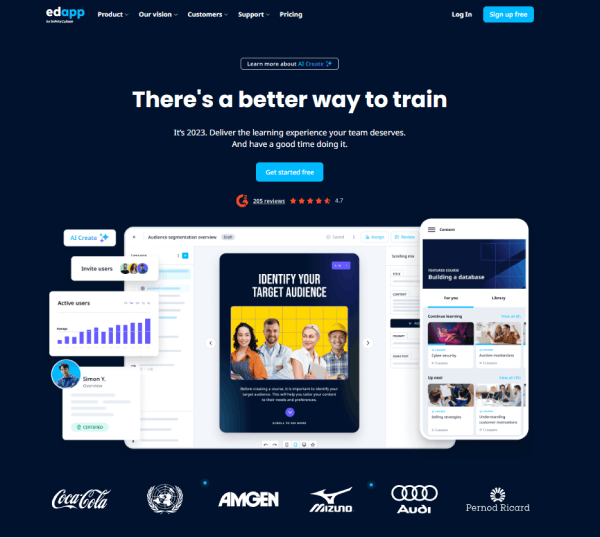How to create effective product training that works

In the ever-changing landscape of the business world, it’s important to keep your products and services ahead of the competition. You can't afford to stay the same when you're up against companies offering identical products or services.
According to an article in the Harvard Business Review, it’s important for companies to excel at learning new things to succeed in a risky business environment. In other words, you need to continuously refine your products and even explore innovations whenever possible.
But how do you effectively educate your employees, sales reps, or channel partners about these product changes? The answer is simple: product training.
In this article, we’ll unpack the secrets of creating effective product training that truly works. We'll explore the significance of product training, and give you a practical step-by-step guide to make your training sessions engaging and effective. And that's not all – we'll introduce you to a powerful tool, EdApp, that will transform the way you design, deliver, and measure the impact of your product training.
But first, let’s define what product training is.
What is product training?
Product training, in simple terms, is a program designed to educate your team about the ins and outs of your product, how it works, and the benefits it brings to your customers. The goal is to equip your team with the knowledge they need to fully understand, promote, and sell your product or service.

While product training is open to all employees, it holds the greatest value for your customer service, sales, and marketing teams as well as your channel partners. This is because they’re the frontline ambassadors of your product. Hosting comprehensive product training empowers them with all the information they need to effectively communicate the value of your product, handle customer inquiries with confidence, and ultimately drive sales.
The importance of effective product training
Effective product training is not just a nice-to-have – it plays an important role in the success of any business. Here are some reasons why it's extremely important:

It helps close more deals
Studies have shown that businesses prioritizing effective training, coaching, and professional development usually outperform their competitors. In fact, they achieve sales objectives that are remarkably 17% higher than those who fall short in these areas.
The reason behind this impressive statistic is simple: product training works wonders for your teams. By giving them in-depth knowledge, product training boosts their confidence to understand customer needs, tailor their selling strategies, and close more deals.
It brings the skills of your sales team to new heights
Your sales teams already possess a strong set of selling skills, and when combined with effective product training, they can maximize their potential. By engaging them in comprehensive product training, they can effectively apply their sales skills and close more deals. In fact, they might even have the opportunity to upsell and cross-sell, further boosting their sales performance.
It builds long-term relationships with customers
A well-trained team with competitive product knowledge can handle customer inquiries and support requests more efficiently. Being well-versed in your product, they can better understand customers' pain points and offer them solutions promptly and accurately. This level of support showcases your commitment to customer satisfaction, strengthening relationships, and fostering loyalty.
It promotes cross-functional collaboration
Product training can also help establish cross-functional collaboration among employees from different departments. When everyone in your organization shares a common understanding of your products, they can communicate more effectively about new product information or updates.
They can seamlessly work together to solve common problems and even identify potential product improvements. Building this type of culture can bring your business forward and make sure that your product remains competitive in the market.
Take your product training to the next level – join EdApp today!
Different product training examples to consider
Now that we've got a solid grasp of what product training is and why it's so important for businesses, let's dive deeper and explore some examples of product training.

Pro tip – incorporate a mix of these training examples. By incorporating a variety of approaches, you can cater to different types of learners and achieve maximum learning outcomes.
Hands-on workshops
Conduct hands-on workshops where participants can directly interact with the product. This learning approach allows them to explore product features, understand functionality, and gain practical knowledge through guided activities and demonstrations.
Gamified learning
Put a little spice into your training by incorporating the idea of gamified learning. This training example has been proven to be effective in increasing a learner’s level of engagement. By adding game elements such as points, levels, challenges, and rewards, your learners will be motivated to participate and engage in your training, resulting in better training outcomes.
Virtual Reality (VR) modules
Make use of the power of virtual reality technology to create immersive product training experiences. VR modules allow learners to explore virtual environments, interact with product simulations, and gain a realistic understanding of product functionality, leading to enhanced learning and retention.
Microlearning courses
Break down your product training into bite-sized, focused courses and deliver information in a concise and easily digestible format. This product training example helps learners access relevant product knowledge, anytime and anywhere. Whether it's during a lunch break or while commuting, microlearning gives your team the flexibility to learn at their convenience, without the need to disrupt their work routines.
How to do product training: your step-by-step guide
Here, we’ll guide you through the essential steps to create effective product training. Use this step-by-step guide to level up your product training and make sure it leaves a lasting impact on your team.

Step 1: Analyze training needs
Before creating your product training, it’s important to first conduct a thorough analysis of your training needs. Start by identifying the individuals who will be receiving the training and delve into their specific roles and responsibilities within the organization. From there, consider the benefits that this product knowledge will bring to their work, such as empowering them to enhance their sales skills, refine their marketing materials, or even improve customer support interactions.
Step 2: Develop clear learning objectives
After analyzing the training needs, you then need to set clear and measurable learning objectives for your program. Define what participants should know and be able to do after completing the training. These objectives will serve as guideposts, directing the content and activities of your training to make sure they align with the desired outcomes.
Step 3: Design engaging content
The next step in how to create your product training is creating your instructional materials. But it goes beyond just putting together a boring product presentation in PowerPoint or PDF. You need to make sure that your content is visually appealing, concise, and easy to understand, so your learners can get the most out of it.
Think outside the box and mix things up with engaging formats like videos, eye-catching images, and interactive modules. By adding some variety to your product training, you'll keep your learners hooked and actively engaged throughout their learning process.
Step 4: Choose the right training delivery method
Now that you have your awesome content all set, it’s time to choose the right delivery methods for your product training. We all know that each learner has their own unique style and preferences when it comes to learning, which is why it’s important that you have a range of training delivery options.
Some of the most common delivery methods include:
- Online learning - it allows learners to learn at their own pace, whenever and wherever they prefer.
- In-person workshops - they bring your learners together in the same location and time for a more immersive and interactive learning experience.
- Virtual training - it delivers training sessions remotely while still facilitating real-time interaction.
- Blended training - it combines different delivery methods so learners can benefit from various learning environments.
Step 5: Assess training progress
Assessments help you find great insights into the knowledge retention of your learners and identify areas where further improvement may be needed. Quizzes, case studies, and practical exercises are the most effective assessment tools. You can sprinkle them throughout your training program, or offer them at the end of your course.
Step 6: Offer post-training resources
To foster continuous learning and reinforce the knowledge gained during product training, it’s beneficial to offer post-training resources to your learners. These resources can include manuals, quick reference cards, or step-by-step guides that summarize key concepts, processes, or product features.
With these resources at their fingertips, learners can reinforce their training and apply their newfound knowledge with ease. It's like having a helpful toolkit that supports them in putting their learning into action and becoming true experts in your product or service.
Why is EdApp the best tool for creating effective product training?
EdApp stands out as the best tool for creating effective product training, offering a range of features and tools that transforms the way you design, deliver, and measure the impact of your product training.

Here's why it stands out:
- AI-powered creator tool - it helps you generate courses in just a click of a button – no brainstorming or research necessary. Even better, you can easily edit the lessons and put your own content, such as your product features and benefits.
- Microlearning courses - if you don’t want to start your training from scratch, you’d be glad to know that EdApp offers ready-made product training courses that are based on the microlearning approach. These courses will help you deliver bite-sized training content that fits into the busy schedules of your learners.
- Rapid Refresh - this quiz maker tool can instantly set up your quizzes and assessments and automatically deliver them to your learners. Here, quizzes are automatically generated after filling out the spreadsheet. They are designed using a variety of gamified templates such as multiple-choice, true or false, matching tiles, and more.
- Gamification tool - EdApp's built-in gamification features, such as points, badges, and leaderboards, make learning fun and engaging. These gamification elements motivate learners to complete their training modules and achieve higher scores.
- Analytics and reporting - you’ll also benefit from EdApp’s robust analytics and reporting tools that can help track your learners’ progress and identify knowledge gaps. You can even export your data to CSV or XLS file formats so you can delve deeper into your data and make further analysis.
And best of all? EdApp’s mobile-first approach gives your learners accessibility and flexibility in their learning. Meaning, they can access training content anytime, anywhere.
Level up your product training with EdApp's powerful training tools!
Author
Jen Avelino
Jen is a learning expert at EdApp, a mobile-based training platform that helps corporates and businesses bring their training solutions to the next level. She carries an extensive writing experience in a variety of fields, including architecture, the gig economy, and computer software. Outside of work, she enjoys her free time watching her favorite series and documentaries, reading motivational books, and cross-stitching.
